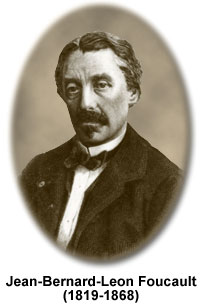Jean-Bernard-Leon Foucault
(1819-1868)

Jean-Bernard-Leon Foucault was a French physicist who is considered one of the most versatile experimentalists of the nineteenth century. He is well known for his experiments in optics and mechanics and was involved in the development of a method to measure the speed of light with extreme accuracy. Foucault is most often remembered for proving, with the use of a pendulum, that the Earth rotates on its axis.
On September 18, 1819 Foucault was born in Paris, France, the son of a publisher. His early education was received at home and he showed youthful promise in mechanics. After obtaining his bachelor of arts degree, Foucault entered medical school but soon abandoned the program. Instead, he began working for Alfred Donne, making preparations for a university medical microscopy course. Since his elementary mathematical and scientific training had been inadequate for his interests, Foucault supplemented it as he became involved with invention and experiment.
Foucault met the French physicist Armand Fizeau in 1839 and the pair worked in close collaboration for almost a decade. Together they took the first detailed pictures of the sun's surface and developed a more precise way to measure the speed of light in 1849. Foucault proved independently that the speed of light in air is greater than it is in water. His other contributions to the field of optics included a method of measuring the curvature of telescope mirrors, an improved technique to silver astronomical mirrors, a method of testing telescope mirrors for surface defects, and the invention of a polarizing prism to orient and manipulate polarized light.
Succeeding Donne as the scientific editor of the French publication Journal des Débats in 1845, Foucault's most widely recognized feat was not completed until several years later. While employing a pendulum to create a clock used for controlling telescopes, he stumbled upon the idea of applying the technique to prove that the Earth rotates on its axis. Foucault based his proof on Newton's law, which states that when a body is set in motion, it will move in a straight line from its origin, as long as it is not influenced by outside forces. Foucault demonstrated his proof for the first time at the 1851 World's Fair in the Pantheon in Paris. He showed that although the pendulum seemed to change its path during the day, it was actually the floor that was rotating underneath the pendulum. Because the floor is attached to the Earth, it must be the Earth that is rotating.
The gyroscope was another device invented by Foucault to demonstrate the Earth's movement around its axis. The apparatus he designed earned him the Cross of the Legion of Honour and is the basis of the modern gyrocompass. Foucault was given the position of physicist of the Paris Observatory beginning in 1855 and was one of the first to demonstrate the existence of eddy currents generated by magnetic fields, which are sometimes referred to as Foucault currents. Other honors bestowed upon him include the Copley Medal of the Royal Society of London, as well as election into the Bureau of Longitudes and the French Academy of Sciences. His successful career was ended prematurely, however, when he suffered a sudden stroke of paralysis and died at the age of 48.
Measuring the Speed of Light - Starting with Ole Roemer's 1676 breakthrough endeavors, the speed of light has been measured at least 163 times by more than 100 investigators utilizing a wide variety of different techniques. Finally in 1983, more than 300 years after the first serious measurement attempt, the speed of light was defined as being 299,792.458 kilometers per second by the Seventeenth General Congress on Weights and Measures. Thus, the meter is defined as the distance light travels through a vacuum during a time interval of 1/299,792,458 seconds. In general, however, (even in many scientific calculations) the speed of light is rounded to 300,000 kilometers (or 186,000 miles) per second.
